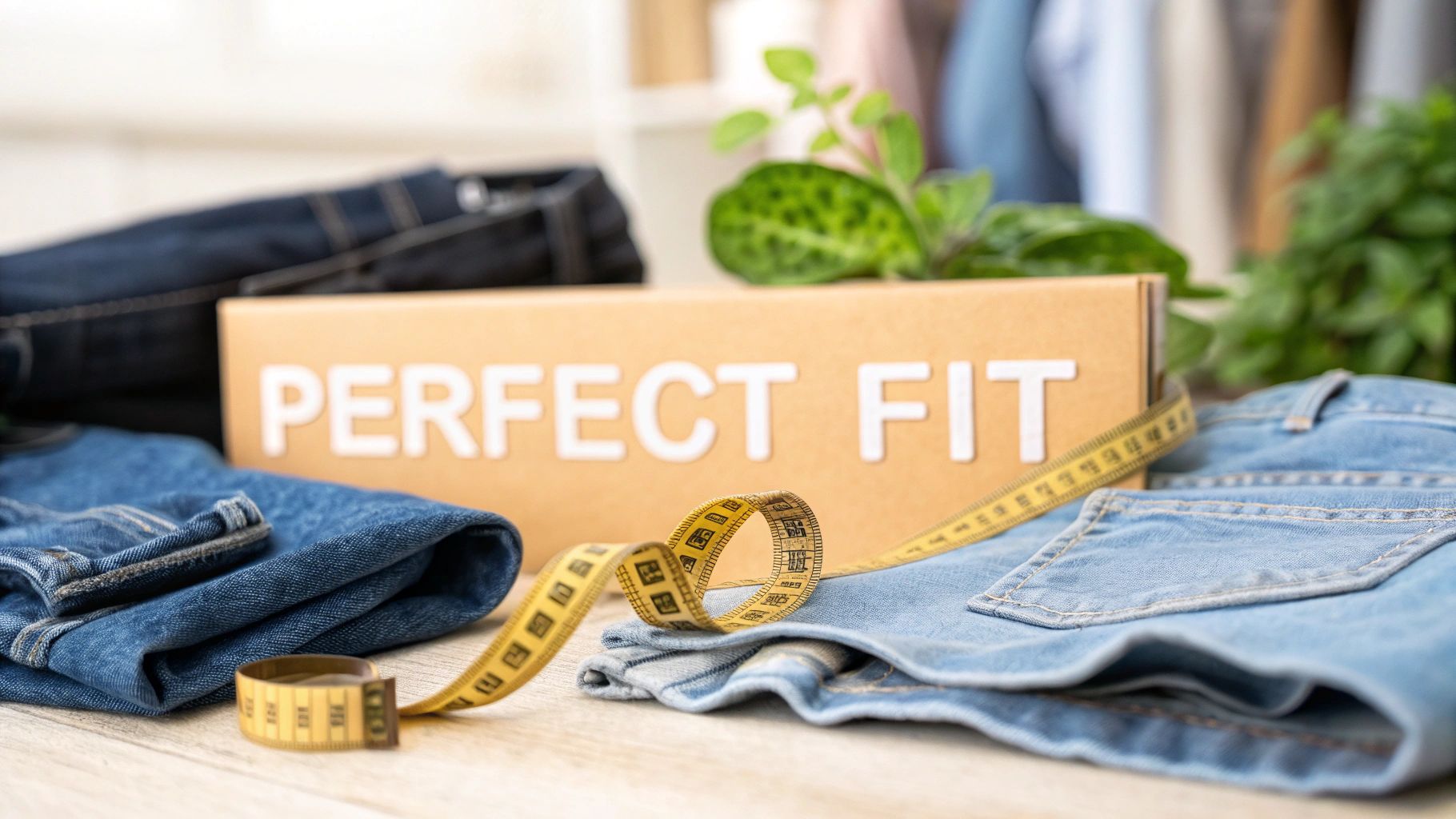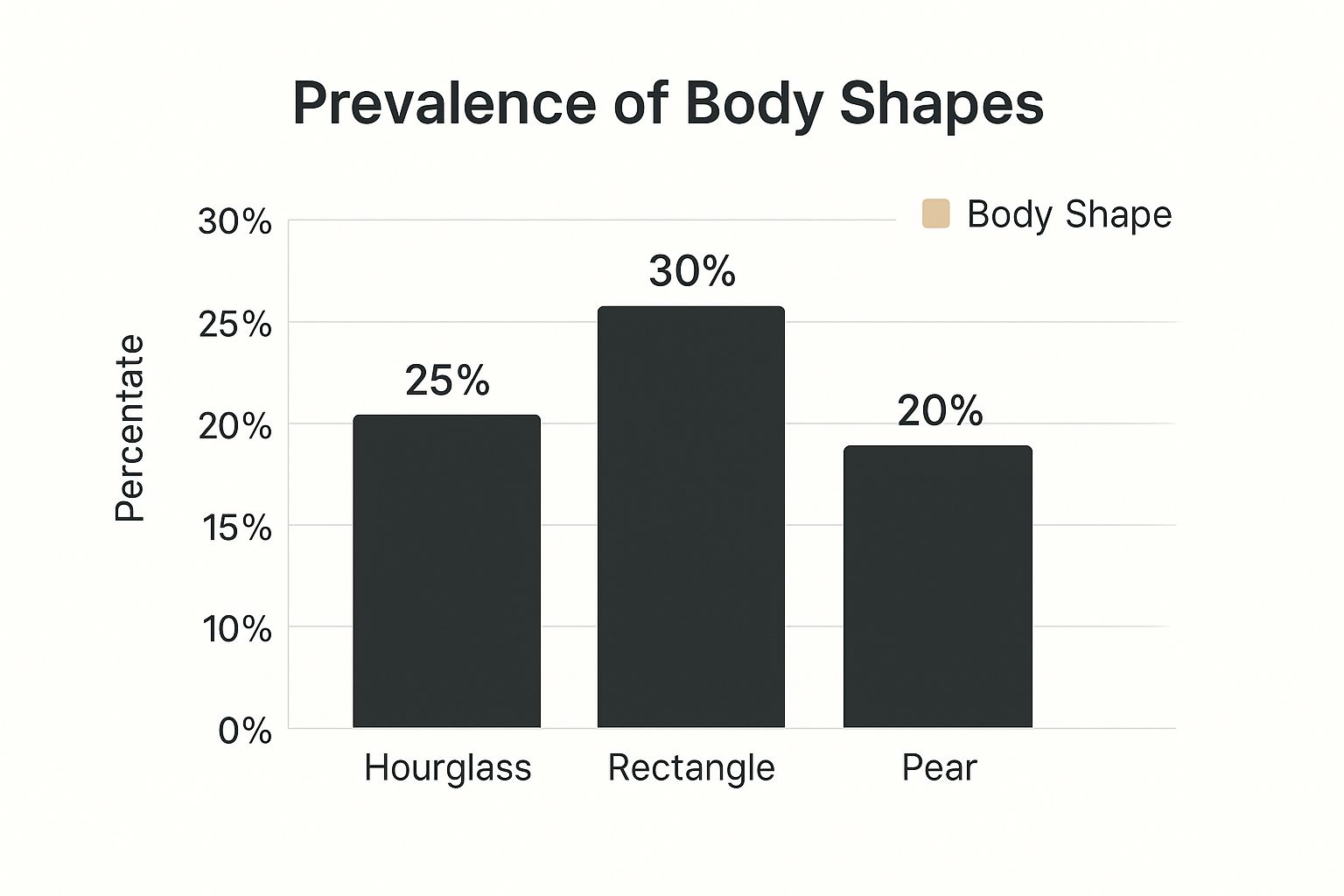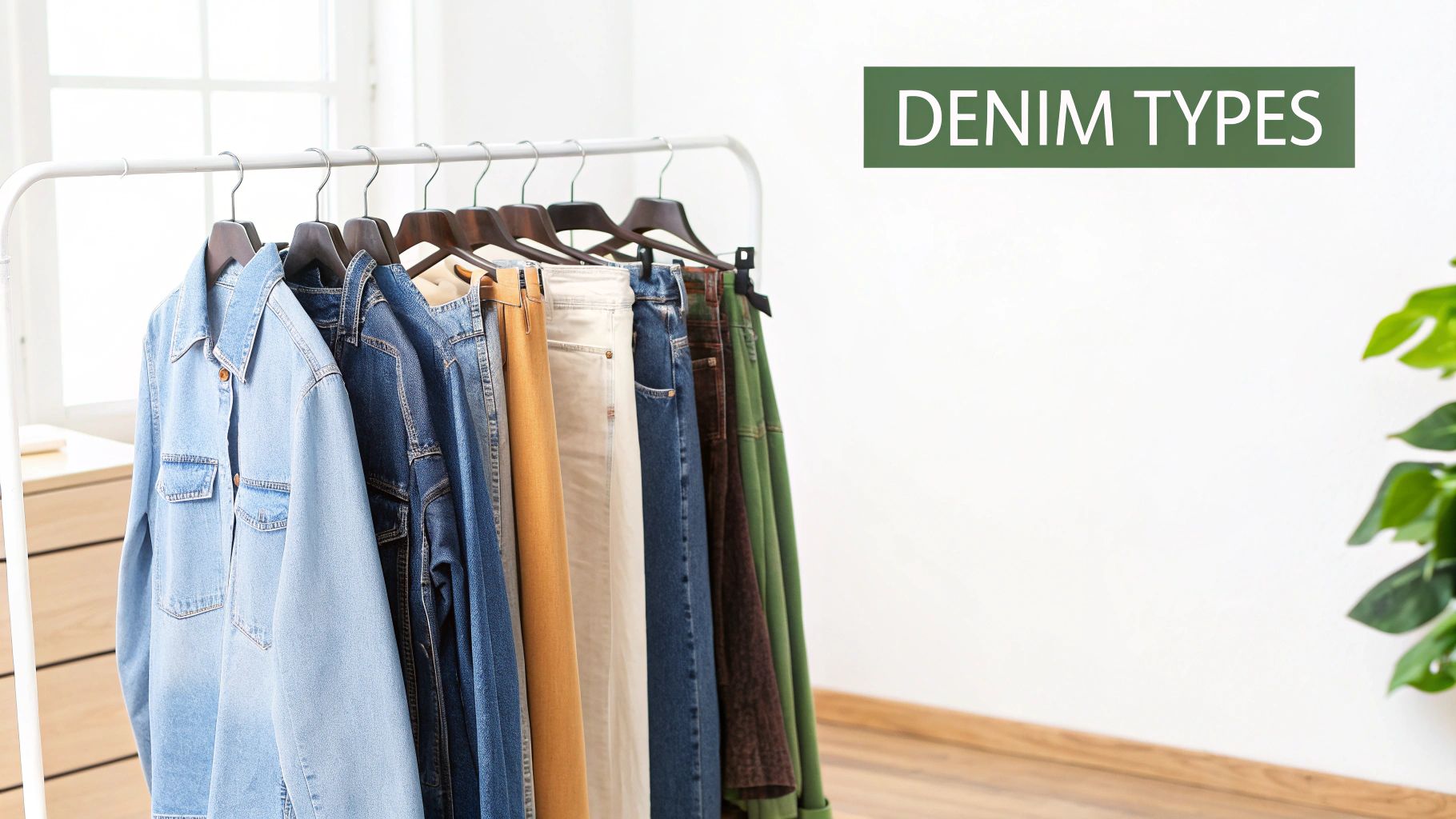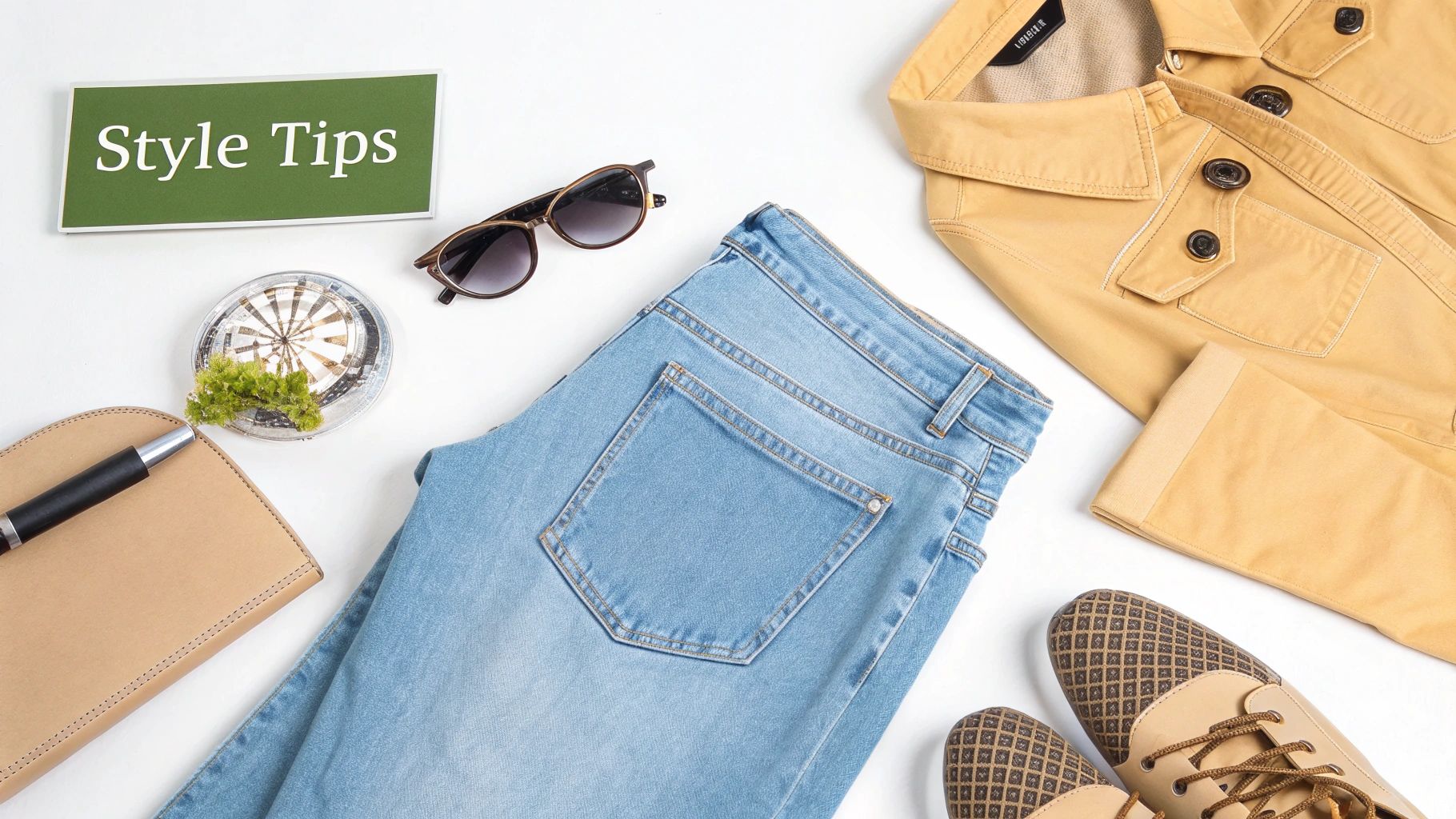How to Choose the Right Jeans: Your Perfect Fit Guide

Let’s be honest: finding a pair of jeans that makes you feel incredible shouldn’t feel like a lifelong quest. The secret isn't about chasing fleeting trends or getting lost in overwhelming racks of denim. It's about having a simple, reliable game plan.
Think of this as your personal cheat sheet for jean shopping. We're going to move beyond those vague, generic sizes and focus on what truly matters for your body and your life. It’s less about following rigid fashion rules and more about making denim work for you.
Start with Your Shape and Style in Mind
The first real step to finding your holy-grail jeans is knowing which styles are built to celebrate your specific body shape. It’s a simple but powerful idea: certain cuts are engineered to balance your proportions, make your legs look longer, or hug your curves in just the right way. Getting this right from the start saves a ton of time and frustration in the fitting room.

As you can see, there’s no single “standard” body type—far from it. This is exactly why a one-size-fits-all approach to jeans almost always ends in disappointment.
The real magic happens when you stop trying to fit into a trend and start looking for a silhouette that honors your individual shape. Confidence comes from a fit that feels like it was made just for you.
Match the Jean Fit to Your Needs
Different cuts also serve different purposes and suit different styles. For instance, market studies show that slim-fit jeans are the top choice for 40-50% of shoppers in North America and Europe, loved for their clean, flattering lines. Meanwhile, classic regular-fit jeans make up nearly 30% of sales in other markets, and skinny fits are still a go-to staple for many. You can explore more about the global jeans market and its trends to see how tastes vary.
To give you a head start, I’ve put together a quick reference table. It maps the most popular jean styles to the body types they tend to flatter best. Use it as a shortcut to narrow down your options before you even step into a store.
Jean Fit and Body Type Compatibility Matrix
| Jean Fit | Best For Body Types | Key Characteristics |
|---|---|---|
| Skinny Jeans | Hourglass, Rectangle | Tightly fitted from waist to ankle, highlighting natural curves. |
| Straight-Leg | Apple, Pear, Rectangle | Consistent width from hip to hem, creating a clean, elongating line. |
| Bootcut/Flare | Hourglass, Pear | Fitted through the thigh with a flare from the knee down, balancing wider hips. |
| Boyfriend/Relaxed | Rectangle, Inverted Triangle | Looser, relaxed fit through the hip and leg for a casual, effortless look. |
Think of this as your starting point. It’s not about rigid rules, but about giving you a solid foundation to find a fit you’ll absolutely love.
Get Your Measurements Right for the Perfect Fit

There's nothing quite like the feeling of a pair of jeans that fits just right—it's like they were made just for you. Getting there starts with knowing your numbers. Brand sizes are all over the place, so learning to measure yourself is the single best way to find a pair you'll actually love to wear.
Forget the brand's size chart for a second. We're going to focus on three core measurements that tell the real story of how a pair of jeans will sit on your body. These are your secret weapons for shopping online with confidence and knowing exactly what to look for on the rack.
The Three Core Jean Measurements
The easiest way to get started is by measuring a pair of non-stretch (or very low-stretch) jeans you already own and feel great in. Just lay them flat on a table and get your measuring tape ready.
- Waist: Measure straight across the top of the waistband, from one end to the other. Double that number, and you've got your true waist measurement. If it's 15 inches across, your waist size is 30. Simple as that.
- Inseam: This one’s all about leg length. Measure from the crotch seam straight down the inside of the leg to the very bottom of the hem. This little number is what stands between you and a pair that's too short or needs a trip to the tailor.
- Rise: This is the unsung hero of a good fit. The rise determines where the jeans sit on your torso, and it's key to both comfort and creating a flattering shape. Just measure from the crotch seam up to the top of the front waistband.
Once you have these numbers, you’re in control. The waist and inseam are pretty straightforward, but you’d be surprised how much the rise can change your entire look. For a deeper dive into how different cuts work with your shape, you can learn more about how to find jeans that fit in our other guides.
Why the Rise Matters So Much
The rise is more than just a trend—it's the foundation of your outfit. It’s what shapes your silhouette and dictates your comfort level all day long.
A high-rise jean, which usually sits right at or even above your navel, is a fantastic choice for making your legs look longer and highlighting your waist. It gives you great coverage and creates a clean, smooth line, especially with tucked-in tops.
On the other hand, a mid-rise is your classic, can't-go-wrong option. It sits just below the belly button, offering a natural fit that plays well with almost any top. It’s the ultimate go-to for everyday wear because it never feels too constricting or too low.
A little tip from my own experience: When you're measuring, pull the tape so it's snug but not digging in. You should be able to slide one finger between the tape and your body. This ensures you're measuring for real-life movement and comfort, not just for a static, perfect number.
By getting a handle on these three simple measurements, you can finally stop guessing. You'll be armed with your own personal data, making it so much easier to find the right pair, every single time.
Decoding Denim: A Guide to Fabric Weight and Weave
The look of your jeans is one thing, but the soul of a truly great pair? That lives in the fabric itself. Understanding the material—its weight, composition, and how it’s woven—is the secret to finding jeans that feel as incredible as they look. It’s the difference between a pair that gives up after one season and one that becomes a trusted old friend for years.

This side of denim might sound a bit technical, but I promise it’s pretty straightforward once you know what you’re looking for. Really, it all boils down to two key things: the fabric's weight and what it’s made of.
The Feel of the Fabric: Understanding Weight
Denim weight is simply how much a square yard of the fabric weighs in ounces. This number tells you a lot about its durability, structure, and how it will hang on your body.
- Lightweight Denim (under 12oz): This is your best friend in warmer weather. It's perfect for styles that need a softer, more relaxed drape. Think of those comfortable, easy-wearing jeans that feel perfectly broken-in from the moment you put them on.
- Midweight Denim (12oz-14oz): Meet the versatile workhorse of the denim world. This weight strikes the perfect balance between durability and comfort, making it the ideal choice for your everyday, all-season jeans.
- Heavyweight Denim (14oz+): Known for its ruggedness, heavyweight denim is incredibly durable and holds its shape like nothing else. It will feel stiff at first and requires a break-in period, but it rewards you by molding to your body for a truly custom fit over time.
A crisp, 14oz raw denim pair will have a substantial, sturdy feel right away, while a 9oz pair with a bit of stretch will feel soft and flexible from the get-go. Neither is "better"—they just serve different purposes. It all comes down to the feel you're after.
The Great Debate: 100% Cotton vs. Stretch
Next up is what the fabric is actually made of. This is where you have to choose between the old-school integrity of pure cotton and the modern comfort of a stretch blend. It’s a personal choice, and there’s no wrong answer.
100% Cotton (Rigid Denim): This is the original, classic denim. It’s famous for its ability to conform to your body over time, creating unique fades and creases that tell your story. It starts out a bit rigid but softens beautifully with every wash and wear, offering unparalleled durability.
Cotton-Elastane Blends (Stretch Denim): For immediate comfort and shape retention, nothing beats a blend. Adding a small amount of elastane (usually just 2-3%) allows the jeans to move with you, preventing that restrictive feeling and helping them snap right back into shape. This makes it a fantastic choice for skinny fits and for anyone who puts flexibility first.
The global denim market, which is expected to hit $121.5 billion by 2030, shows just how much our preferences are changing. While heavyweight, 100% cotton jeans were the longtime standard, the use of stretch blends has jumped from just 10% in 2015 to nearly 35% in recent years as we all look for that perfect mix of quality and comfort. You can see more on this trend by checking out the denim market analysis on Grandview Research.
The takeaway is simple: if you want jeans that tell a story and mold to you over years, choose rigid cotton. If you need instant comfort and a fit that forgives, opt for stretch.
Choosing between fabrics is just as personal as choosing a cut. If you're looking for a little more guidance on which style is right for you, be sure to check out our complete jeans fit guide.
Finding Jeans That Celebrate Your Body

Alright, you’ve got your measurements and a feel for different fabrics. Now for the fun part—choosing a style that truly celebrates you. This isn’t about squeezing into a trend or following a rigid set of rules. It’s about understanding proportion and using denim to your advantage to create a silhouette that feels amazing.
Think of your jeans less as a piece of clothing and more as a tool for creating balance. When you find cuts that work with your natural frame, you get to highlight all the features you love.
For Women: Finding Your Most Flattering Fit
For women, the magic often happens when you balance your upper and lower body. The right cut can create an elegant, elongating line that makes you feel like you can take on the world.
-
Pear Shape (Wider Hips): If your hips are fuller than your shoulders, you want to create a little balance on your lower leg. This is where bootcut and flare jeans shine. That subtle kick at the hem works wonders, visually balancing your hips and creating a beautiful hourglass silhouette.
-
Apple Shape (Fuller Midsection): For anyone carrying more fullness around the middle with slimmer legs, a great high-waisted jean is your best friend. A high-rise straight-leg or slim-fit style gives you comfortable support where you want it while beautifully showcasing your legs.
-
Hourglass Shape (Defined Waist): If you have that classic defined waist with balanced hips and shoulders, you’re in luck—most styles will look fantastic. A high-waisted skinny or slim-straight jean is especially great for highlighting your natural curves.
-
Rectangle Shape (Straight Figure): For a straighter frame where your shoulders, waist, and hips are all in line, jeans are a great way to create curves. A slouchier boyfriend jean can add a touch of volume to your hips, while a bootcut creates the illusion of a curvier lower body.
-
Petite Frame (Shorter Stature): To create the feeling of longer legs, think about clean, unbroken lines. A high-waisted straight-leg or skinny jean in a solid dark wash is incredibly elongating, especially when you pair it with even a small heel.
Style is timeless, but our needs can certainly evolve. For more tailored advice, our guide on the best jeans for older women has some incredible tips for blending classic style with the comfort we all crave.
A great pair of jeans doesn't hide your body—it celebrates it. The right fit works with your proportions, creating a sense of balance and letting your confidence shine through.
For Men: Nailing a Modern Silhouette
For men, the right pair of jeans is all about finding that sweet spot between comfort and a modern cut. The right fit can be the difference between looking sharp and feeling sloppy, and it often just comes down to the silhouette.
A slim-straight fit is an incredibly versatile choice, especially for more athletic or larger frames. It gives you a bit more room through the seat and thighs than a true slim fit, but it tapers just enough from the knee down to keep the look clean and contemporary, never baggy.
For leaner builds, a classic slim-fit jean is a go-to. It follows the line of the leg a little more closely, which adds some nice structure and definition to your frame without ever feeling restrictive or "skinny." It’s a polished look that moves effortlessly from a casual weekend to a smart-casual night out.
Insider Tips for Trying On and Buying Jeans
https://www.youtube.com/embed/fJ1VkjV8Ks0
This is it. The fitting room is where all your research and wishful thinking finally meet reality. Think of it as the final checkpoint before you commit, and knowing a few simple tricks can save you from that sinking feeling of buyer's remorse later on. A few key moves will tell you everything you need to know about how a pair of jeans will really feel and behave out in the wild.
Before you even start the buttoning-up struggle, just feel the fabric. Get a sense for its weight and stretch. If the jeans have a good bit of give to them—say, 2% or more elastane—you should seriously consider trying a size down. That super-snug fit in the dressing room almost always relaxes into the perfect, lived-in feel after just a few hours of wear.
The Fitting Room Checklist
Once you've wrangled them on, it's time to put those jeans to the test. Don't just stand there, static and posed. You have to move around like you actually live a life. This is the only way to unearth those little annoyances before they become daily frustrations.
- The Squat Test: I swear by this, and it’s non-negotiable. Drop into a deep squat. Are the jeans pulling down in the back, giving everyone a show? Do they feel like they’re cutting off circulation in your thighs? This one simple move is a masterclass in checking for both comfort and coverage.
- The Sit Test: Find a bench or stool and actually sit down for a minute. Does the waistband dig into your stomach? Is the fly pulling or creating a weird pucker? A great pair of jeans should feel just as good when you're sitting at your desk or grabbing coffee as they do when you're standing.
Key Takeaway: The most obvious red flag for a bad fit is that dreaded waistband gap. If you can easily slide more than two fingers between your back and the waistband, that cut just isn’t made for your curves.
A gap at the back is a tale as old as time, but it's not a dealbreaker. It often just means you need a style with a more contoured waistband designed to hug your hips. If you've been plagued by this, you can learn all about what causes a jeans gap in the back and, more importantly, how to finally beat it.
Smart Shopping Online
Taking the jean-buying experience online means losing the fitting room, but you gain a whole new arsenal of tools. Success here comes down to becoming a bit of a detective. Don't just get mesmerized by the glossy product shots on a flawless model. The real gold is in the customer reviews.
I always scroll straight past the five-star "love them!" comments and look for the detailed reviews. Find people who mention their own height, weight, and general body shape. Their honest feedback is priceless for getting a sense of how a style truly fits a real body.
And my final piece of advice? Before you even think about clicking that "buy now" button, find and read the return policy. A generous, hassle-free return process is your ultimate safety net when you're shopping for denim from your couch.
Still Have Questions? Let’s Clear Things Up
Even after you've measured and narrowed down your choices, a few last-minute questions always seem to pop up in the fitting room. It happens to all of us. Let's walk through those final hesitations so you can walk out with a pair of jeans you truly love.
Are My Jeans Too Tight, or Will They Stretch?
This is the age-old denim dilemma. For new jeans made from 100% cotton—the rigid, old-school kind—you're looking for a snug fit. They shouldn't be painfully tight, but they should feel substantial. You need to be able to sit down comfortably and bend your knees without the waistband feeling like a vise.
A great little trick I've always used is the "two-finger rule." If you can't slide two fingers between your waist and the denim, they're probably a size too small.
Now, for jeans with a bit of stretch, the opposite is true. They should feel quite fitted when you first try them on because they will loosen up, often by about half a size, after you've worn them a few times. If they feel perfectly comfortable right off the bat, you might find they've become baggy by the end of the week.
A good pair of rigid denim jeans starts as a blank canvas. They should feel stiff but wearable, promising to mold to your body over time for a truly personalized fit that tells your story.
Should I Bother Getting My Jeans Hemmed?
Absolutely, yes. A proper hem is one of the easiest and most affordable alterations you can make, and it completely elevates your look from "off-the-rack" to "custom-fit." The perfect length really comes down to the style of the jean and the shoes you'll wear them with.
- For skinny and straight-leg jeans: Aim for the hem to hit right at or just above your ankle bone. It’s a clean, modern silhouette that looks fantastic with everything from sneakers to ankle boots.
- For bootcut or flared jeans: The hem should almost graze the floor when you're wearing your shoes. You want to cover most of the shoe, creating that long leg line, but without dragging the denim on the ground.
Here’s a pro tip I learned the hard way: always wash your new jeans at least once before you take them to the tailor. Denim can sometimes shrink a little in length after its first wash, and you don’t want to end up with accidental capris.
What's the Real Difference Between Raw and Regular Denim?
The main distinction is all in the wash. What we think of as "regular" denim has been pre-washed and treated by the manufacturer to give it that soft, already-worn-in feeling from the moment you buy it.
Raw denim, sometimes called "dry denim," is the complete opposite. It’s unwashed, untreated, and feels quite stiff and rigid at first. This kind of denim requires a break-in period where it gradually softens and fades based on how you wear it, creating a pair that's uniquely yours.
And once you’ve found that perfect pair, taking care of your entire wardrobe becomes even more important. If you’re curious about preserving your clothes for years to come, there are some great guides on how to store clothes long term.
Ready to find jeans that feel like they were made just for you? At JAG Jeans, we design timeless denim with a focus on a flawless, comfortable fit. Discover your new favorite pair today. Shop JAG Jeans Now
Recent Blogs
How to Choose the Right Jeans: Your Perfect Fit Guide
Learn how to choose the right jeans with expert tips...
How to Choose the Right Jeans: Your Perfect Fit Guide
Learn how to choose the right jeans with expert tips...
How to Choose the Right Jeans: Your Perfect Fit Guide
Learn how to choose the right jeans with expert tips...